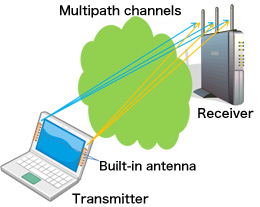
An enormous volume of information is being transmitted around you by invisible radio waves. You also use radio waves to transmit and receive information. The Laboratory of Intelligent Communications conducts research on signal-processing techniques to enhance the performance and efficiency of cell phones, wireless LANs and other wireless communication technologies. For example, a technology called MIMO enables the multiplication of the possible data transmission rate without increasing the bandwidth (a resource for communications). If you use a neighboring mobile terminal of a friend for your data transmission, you can significantly reduce the transmission power (usage of the battery). The laboratory continues to conduct research on challenging new technologies to achieve a high-performance, efficient wireless communication environment.
MIMO signal processing technology
The wireless communication environment varies from moment to moment as the user (e.g., cell phone user) and objects around the user (people/cars) move. The laboratory proceeds with research on the optimal transmission beamforming and optimal signal detection with multiple transmitting and receiving antennas (MIMO system) in the changing propagation environment (fading).
Terminal cooperative technology
Mobile terminals are so small that they cannot carry a large battery. If high-quality communication to a base station in the distance is necessary, higher transmitting power is required, resulting in shorter air time. At our laboratory we propose a technique by which a mobile terminal communicates with a base station by cooperating with its neighboring terminals. This technique achieves eco technology that will significantly reduce the total transmitting power.
Traffic accident prevention technology
Drivers’ safety awareness is most important to protect pedestrians as vulnerable road users. However, if cars can detect the location of pedestrians, it will be possible to call drivers’ attention. If cars can send a danger signal to other cars behind, it will be possible to warn drivers who cannot grasp the situation by themselves. Our laboratory conducts research on pedestrian detection and vehicle-to-vehicle, road-to-vehicle and person-to-vehicle communication technology through the application of wireless communication technology.


